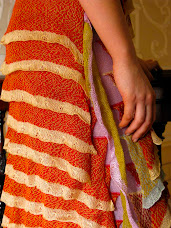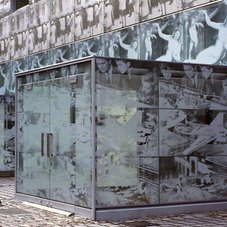 ecomodista spent a month this winter in Copenhagen, Hamburg, and Ribe (the oldest town in Denmark near the west coast of the Jutland) researching a primitive source of warmth--hand knitting--a great substitute for energy consumption. Sex also qualifies as a source of warmth, but one can't or shouldn't indulge in public, giving sweaters an edge. In the course of this research, we also experienced several new buildings in Hamburg, most notably, Europa-Passage, (http://www.europa-passage.de) or arcade, designed by Hadi Teherani one of the largest inner-city shopping malls in Germany. Teherani has been quoted, "The economic and ecological prosaic construction technology in the background, is merely an indispensable precondition...Architecture is defined by atmosphere and not by reason." And the parabolic Europa-Passage is exciting, primarily illuminated by the clear ceiling, and an openess not often encountered in an arcade. Not that our friends, Brigitte and Ulrich were impressed, in terms of the quality of the boutiques, and horrors, a Starbucks! Considered to be spatially innovative, green aspects of the building are the norm in this country. The Germans have built numerous commercial passages, essentially strip malls indoors, sheltering one from the frigid winds off the North Sea, usually on the ground floor of commercial office buildings. Europa-Passage represents a new direction in material consumption modes for the Germans--the mall...
ecomodista spent a month this winter in Copenhagen, Hamburg, and Ribe (the oldest town in Denmark near the west coast of the Jutland) researching a primitive source of warmth--hand knitting--a great substitute for energy consumption. Sex also qualifies as a source of warmth, but one can't or shouldn't indulge in public, giving sweaters an edge. In the course of this research, we also experienced several new buildings in Hamburg, most notably, Europa-Passage, (http://www.europa-passage.de) or arcade, designed by Hadi Teherani one of the largest inner-city shopping malls in Germany. Teherani has been quoted, "The economic and ecological prosaic construction technology in the background, is merely an indispensable precondition...Architecture is defined by atmosphere and not by reason." And the parabolic Europa-Passage is exciting, primarily illuminated by the clear ceiling, and an openess not often encountered in an arcade. Not that our friends, Brigitte and Ulrich were impressed, in terms of the quality of the boutiques, and horrors, a Starbucks! Considered to be spatially innovative, green aspects of the building are the norm in this country. The Germans have built numerous commercial passages, essentially strip malls indoors, sheltering one from the frigid winds off the North Sea, usually on the ground floor of commercial office buildings. Europa-Passage represents a new direction in material consumption modes for the Germans--the mall...
Friday, April 4, 2008
a primitive source of warmth
The Danes and Germans are incredibly energy conscious, despite rampant freezing temperatures. In fact, in Copenhagen, our hostess, Anne met us at the train station on her bicycle, and there were numerous cyclists on every street. ecomodista loves the fact that one can leave a bicycle on the street without security chains and locks. According to Anne, the only time one really needs to be concerned is New Year's Eve, when those in a drunken stupor might "borrow" one's bike to ride home.
Copenhagen is definitely the city for au courant knitwear, from hand knits to machine knits, everyone wears layers of sweaters and scarves. The best selection of scarves is found at the Tekstilgalleriet, http://www.textilgalleriet.dk/ Not only fashionable, knits continue to provide utility and warmth for which they were originally designed. In northern sea faring climates, fishermen relied on wool sweaters that retain body heat even when wet from the fiercest storms and sheets of rain, a tradition traced back to Vikings, who practiced a form of knitting, nälbinding, a looping technique involving a single needle.
Also known as netting without knots, nälbinding continued to be used until the innovation of knitting with two needles arrived, migrating north from what is now Germany. Knitting has become synonymous with Nordic countries, and while one might be more familiar with Norwegian Setesdal sweaters, Denmark is also home to internationally recognized knitters. See http://www.isagerstrik.dk/1-35-topmenu-1.html for Marianne Isager's site, her daughter, Helga Isager, http://www. amimono.dk and Vivian Hoxbro, http://www.viv.dk/English/default.htm
From Hamburg, we took a train north to Ärhus, the second largest city in Denmark, a country which has a population of 5.5 million (ecomodista loves tiny tiny countries). Textile artist, Ruth Sørenson met us at the station, but had some difficulty recognizing us, having described myself as blond, and Wayne and I wearing black. You can imagine how many blonds there are in Denmark, not to mention everyone wears black. Fortunately, we had our comrade in arms, our faithful, but vicious pekingese, Tong Zhi, as an additional identifying factor. Ruth drove us to Ebeltoft, a small fishing village in Djursland, where she lives. I had made an appointment with Ruth to interview her and make photographs of her work, not on a model, unfortunately, that must wait until warm weather pervades the north, about July. Ruth kindly invited us to stay with her, but having a dog with a NYC bite number (two bites and you and your dog are out) we declined, concerned for her and her husband's safety.
Ruth Sørenson studied textile design at Designskolen Kolding. Hand knitting was included in the curriculum. At the time, Ruth disdained knitting, preferring weaving, and other art forms. When her children left home, four years ago, she decided to research knitting and wool in the Faroe Islands and Shetland Islands, which has since inspired her designs. Working in the traditional stranding technique, her work is stunningly innovative yet simultaneously traditional. See http://www.ruths.dk/engelsk/index.htm
Posted by
ecomodista
at
9:22 AM
 Labels:
Copenhagen,
Designskolen Kolding,
Ebeltoft,
Europa-Passage,
Hadi Teherani,
Hamburg,
knitting,
Ruth Sørenson
Labels:
Copenhagen,
Designskolen Kolding,
Ebeltoft,
Europa-Passage,
Hadi Teherani,
Hamburg,
knitting,
Ruth Sørenson

construction detail of michael reynolds earthship






